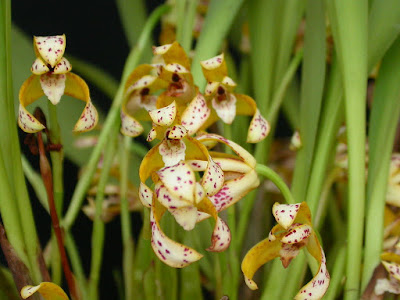Maxillaria picta is native to Brazil and Argentina. They are usually growing on trees in mountainous regions that are characterized by temperate to cold temperatures...
Maxillaria picta also called as The Painted Maxillaria, Bolbidium pictum, Brasiliorchis picta, Brasiliorchis rupestris, Epidendrum uniflorum, Maxillaria fuscata, Maxillaria hoehnei, Maxillaria kreysigii, Maxillaria kreysigii, Maxillaria leucocheila, Maxillaria monoceras, Maxillaria picta var rupestris, Maxillaria punctate, Maxillaria rupestris var brevis, Maxillaria rupestris var minor, is a species of the genus Maxillaria. This species was described by William Jackson Hooker in 1832.
IDENTIFY MAXILLARIA PICTA
Maxillaria picta is native to Brazil and Argentina. They are usually growing on trees in mountainous regions that are characterized by temperate to cold temperatures. In Brazil, the area of the natural environment of this species extends south of the states of Minas Gerais and Rio de Janeiro through Sao Paulo, Parana, Santa Catarina and Rio Grande do Sul.
It is a medium sized, warm to cool growing epiphyte and occasional lithophyte, which reaching a height of 28-46 cm, with erect, ovoid-conical to ovoid-oblong, longitudinally sulcate, 4-7 cm high and 2.5-4.0 cm wide pseudobulbs that are enveloped basally by several scarious sheaths and carrying 1 to 2, coriaceous, linear-lanceolate, to linear-oblong, obtuse, 20-38 cm long leaves that are attenuate into the petiole below.
The Painted Maxillaria blooms in the winter and spring on a basal, erect, single flowered inflorescence and carrying sometimes fragrant flowers. The flower with a distinct texture, in the shape of a chalice, does not open fully and is approximately 6.4 cm in diameter. The flakes of both whorls are bright-yellow on the inside and whitish or pale yellow, decorated with dirty-gray or light-purple spots on the outside. The inner whorl flakes have a red streak on the inner side near the base. The lip is yellowish-white, decorated with purple spots and stripes on the upper surface of the narrow, straightened side plots. The spine is purple.
MAXILLARIA PICTA CARE AND CULTURE
Cultural information should only be used as a guide, and should be to be adapted to suit you. Your physical location; where you grow your plants, how much time you have to devote to their care, and many other factors, will need to be taken into account. Only then can you decide on the cultural methods that best suit you and your plants.
Light:
Maxillaria picta needs a light level of 20000-30000 lux. Moderately bright light should be filtered or dispersed, the plants should never be exposed to the direct effects of the midday sun. The strong air movement should be ensured at all times.
Temperature:
The average temperature of the summer day is 22-24 ° C, night 15-16 ° C with daily amplitude of 8 ° C. If a cooling air humidifier is used, the plants will grow well near the cold, moist outlet. In winter, the average day temperatures are 17-18 ° C, and the night around 10 ° C with the daily amplitude of 7-8 ° C.
Humidity:
The Painted Maxillaria needs the humidity of about 80% for most of the year with a decrease to about 75% in winter.
Substrate, growing media and repotting:
Maxillaria picta can be grown both in pots with good drainage as well as mounted on a piece of cork oak or tree fern. However, it should be remembered that in the second case the plants require high humidity, and during hot and dry weather it may be necessary to water several times each day.
For this reason, it is easier to grow in pots or hanging baskets filled with very loose, quickly drying substrate. The most commonly used growing medium is medium-sized fir bark or shredded tree-fern fiber with the addition of coarse pearlite to keep the substrate cool while providing the right amount of moisture. The addition of charcoal also has a positive effect on the structure of the substrate and prevents its acidification.
The plants should be repotted immediately if the substrate is decomposing or when the pot is too small. Repotting is best done at the time of emergence of new roots, which guarantees that the plant will regenerate its strength in the shortest possible time.
Watering:
Maxillaria picta should be watered abundantly during active growth from late spring to autumn. In late autumn, waterings should be reduced.
Fertilizer:
During the period of active growth, the plants should be fertilized every week with 1/4-1/2 doses of fertilizer for orchids. You can use sustainable fertilizer throughout the year, but also can use a high nitrogen fertilizer from spring to mid summer, then in late summer and autumn use fertilizer with a predominance of phosphorus.
Rest period:
Maxillaria picta grows well at moderate, cool and even very low temperatures. In winter, they needs less water, but the substrate can not dry out completely, nor should it stay dry for a longer period of time. Fertilization should be reduced or completely eliminated until new increments appear and normal spring watering begins.















COMMENTS